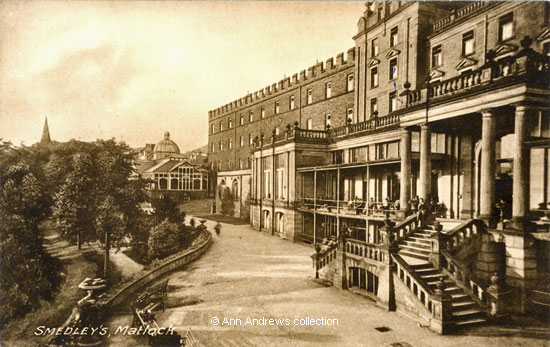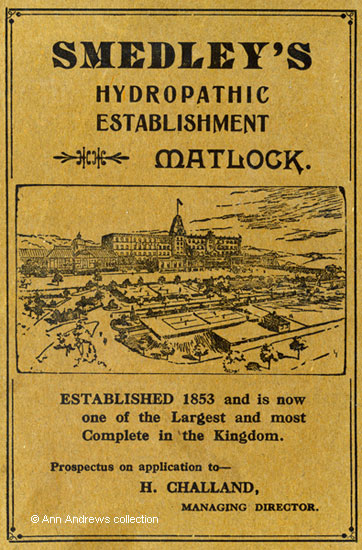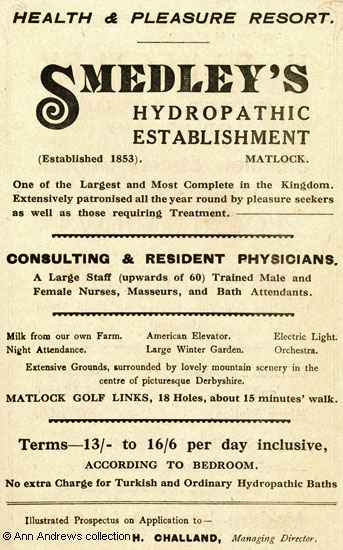|
Images Index> 20th & 21st Century, Matlock> This page |
| Matlock: Smedley's Hydro during the First World War |
| Eighteenth and Nineteenth Century : Photographs, Postcards, Engravings & Etchings |
|
||||||||||||||||
Many of Matlock's hydros were requisitioned in the First World War, but Smedley's functioned normally and the permanent residents were largely undisturbed. The hydro had to take some Service personnel who needed either treatment or convalescence, but the numbers were limited[2]. So, although the Hydro could not develop and grow during the War, at least the management did not face a repair bill afterwards. In 1916, for example, the hydro's manager Henry Challand advertised the hydro as the "Largest and Most Complete. Extensively patronised all the year round as a HEALTH and PLEASURE RESORT; there being an average of over 240 visitors daily in residence. Illustrated Souvenir on application"[3]. As with many other establishments, a large number of male employees joined up and several were killed in the conflict (see War Memorials). At the annual shareholders' meeting on 16th Sept 191 the Chairman reported that "The total number of members of the staff who were serving either in the Army or munitions shops was 30"[4]. He also paid trubute to Bertie Checkley, who had been killed in the August[4]. One of those returning from France to work at Smedley's after the War was Harry Douglas, who had been the hydro's Book-keeper before the War. He did not return from the Front until the very end of February 1919; the High Peak News reported that Captain Douglas, as he had become, and another local man, "have done splendid work for the Country during the whole of the war and are still doing it"[5]. Harry Douglas was not finally demobilised until mid November 1919[6]. "Smedley's was to emerge triumphant and more popular than ever from the war years, but it was a more modern, go-ahead, up-to-date institution, which John Smedley would scarcely have recognised[2]". At the Hydropathic Company's annual meeting in September 1919 the chairman, Mr. William Crowther, said that although the directors had been compelled to increase their charges, they were not in proportion to those of other places". Their profits were lower, although the work done was in excess of previous years. Mr. William Crowther and Mr. H. Bunney were appointed directors, with Mr. Bunney replacing the late Mr. William Quilliam[7]. At the company's meeting the following year Mr. Crowther announced that necessary improvements to the kitchen and dining room, estimated as costing £25,000, were in hand. It would mean the hydro could cope with the increased business it had generated. He added that the cost of food had increased 135% since the war, whereas their charge had only been raised by 40%, with the total income for the past year - £88,076 - being the highest on record. This was a good start to the inter war years. The two advertisements below, the first from the back cover and the second from within the text of a local guide, show what was available at the hydro in the second decade of the twentieth century.
A selection of pictures, found in the Vernon Lamb Archive, of Smedley's staff just before the war:
|
||||||||||||||||
1. "Smedley's, Matlock". Published by Chas. Colledge, Stationer, Matlock. Printed in England, ½d. Stamp inland, 1d Foreign. Not posted, but 1918 or before. Personal Christmas Greetings. 2. Advertisements from "Guide to Matlock and Matlock Bath". Printed and published by Geo. Hodgkinson, Matlock Printing Works. No date and originally thought to be about 1907 but one of the advertisers was not in Matlock until 1917. Postcard and guide in the collection of, provided by and © Ann Andrews. Written, researched by and © Ann Andrews. Intended for personal use only. |
||||||||||||||||
|
[1] Message on another post card card in my (web mistress's) collection. [2] Peach, Lawrence du Garde (1954) "John Smedley of Matlock and his Hydro", Bemrose Publicity Co.: Derby & London. The author claimed that there were around eighty permanent residents throughout the war. [3] "Burnley News", 1 July 1916 (advertisement). Smedley's Hydro Matlock. Established 1853. [4] "Belper News", 17 September 1915. Herbert Samuel Checkley Bertie) is remembered on the Pic Tor memorial. [5] "High Peak News", 1 March 1919. The implication was that Captain Douglas continued to help out with post-war army matters on his return to England. With grateful thanks to Keith Taylor for this information. [6] "Derbyshire Courier", 15 November 1919 [7] "Derbyshire Courier", 20 September 1919. Hydro Profits. Smedley's Chairman and Increased Charges. [8] "Belper News", 1 October
1920. |
||||||||||||||||


















 Read the next stage in the hydro's
history,
Read the next stage in the hydro's
history,